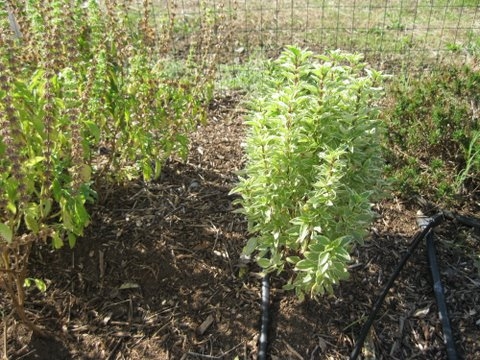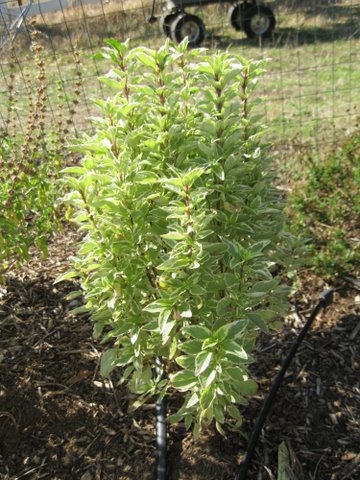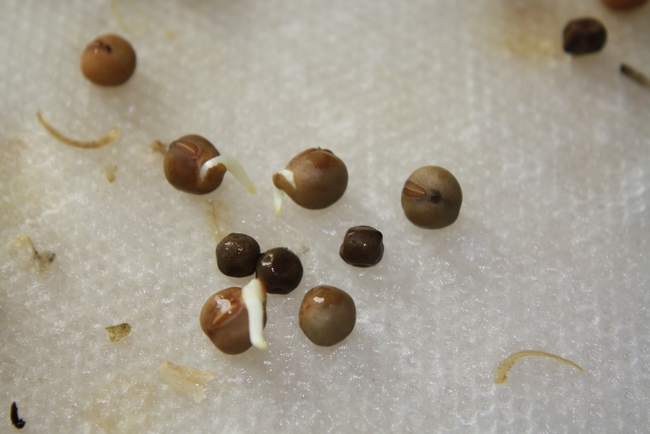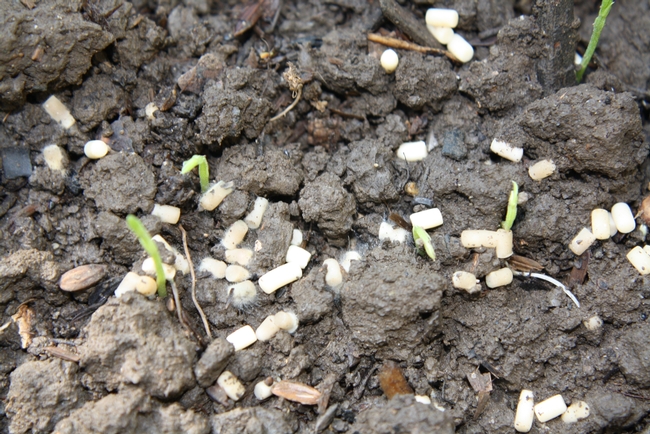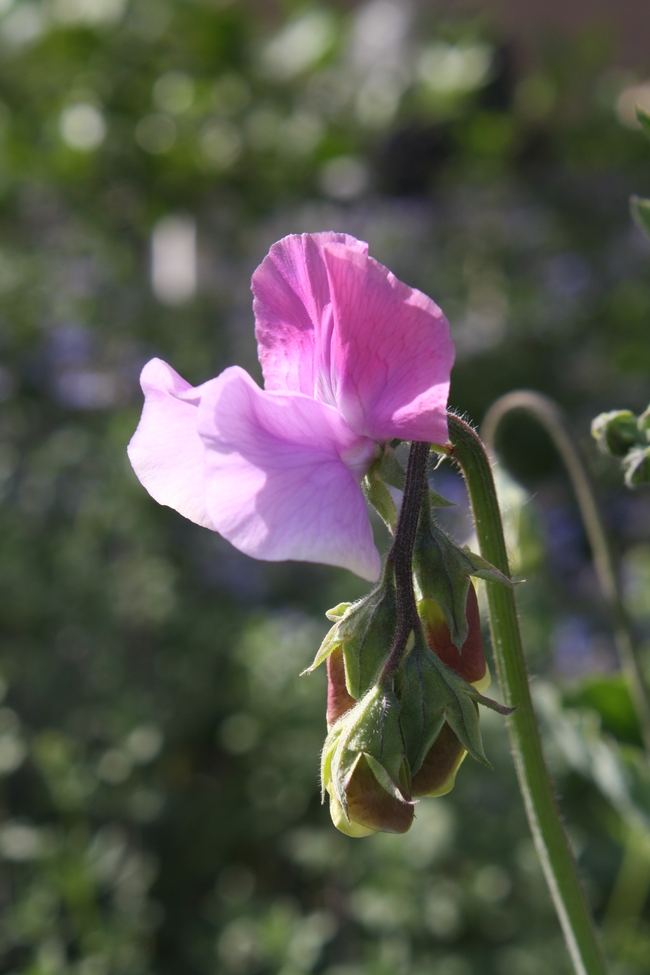Posts Tagged: sweet
UC ANR and San Joaquin Valley cotton growers join forces to prevent sticky cotton in 2015
“It's like having an embarrassing social disease,” Betancourt said. “We want to do better, and we need your help.”
Betancourt was appealing to UC Agriculture and Natural Resources and other experts who were gathered with him at the California Cotton Ginners and Growers Association annual meeting in Visalia. UC ANR entomology specialist Larry Godfrey had begun the pest management session with a somber message. The whiteflies that cotton growers had been controlling reasonably well for more than 20 years was suddenly posing a tremendous challenge.
“I don't know what's up,” said Godfrey, who is housed in the Department of Entomology and Nematology at UC Davis. “It's a different critter.”
Betancourt attested to Godfrey's conclusions. He observed a few whiteflies in the field during the summer of 2013. It was a minor problem. In 2014, he decided to be more aggressive with monitoring and treating for the pest.
“I doubled down last year, but we had a bigger problem with whiteflies,” he said. “I thought, ‘This just can't happen!'”
Whiteflies feed on plant sap and then excrete honeydew. The sweet, sticky honeydew settles on open cotton bolls. If sticky cotton makes its way to spinning mills, it gums up the machinery. It's a scenario that mill managers won't soon forget.
Because of the San Joaquin Valley's long, dry growing season, cotton farmers have earned a reputation for high-quality, high value cotton, said Roger Isom, the CEO of the California Cotton Growers and Ginners Association. Sticky cotton is major concern.
“It happened in Arizona and almost destroyed the state's cotton industry,” Isom said. “Sticky cotton brings mills to a standstill. If they start getting sticky cotton, they'll decide to stop buying from the area where it came from. And once you have the stigma, it's extremely hard to overcome.”
Godfrey said the new biotype of sweet potato whitefly was first found in the San Joaquin Valley in July 1992. Certain areas required careful management, such as those closer to cities where it is warmer and the pest can spend the winter on ornamental plants. Farmers were able to deal with it.
“Then, in 2013 and 2014, populations of whitefly developed in other parts of the San Joaquin Valley, not only adjacent to cities. We don't know why or exactly what is going on,” Godfrey said.
Initially, pest control advisers suspected the whitefly was developing pesticide resistance. UC ANR research trials at the UC West Side Research and Extension Center in Five Points and the Shafter Research Station in Kern County showed that insecticides used at label rates were still able to knock down the pest.
“What we did notice was we had a lot more whitefly and we started seeing them earlier than normal,” Godfrey said. “It certainly makes it more expensive to grow cotton and, if not controlled, makes sticky cotton.”
What's worse, the reputation of cotton in a whole area is tarnished if one or two farmers mismanage the pest and their cotton gets into commercial channels.
“In my area, we have a problem right now and it's not just my problem,” Betancourt said. “Everybody who has whiteflies has to deal with them. We have a reputation to uphold.”
All the growers who send cotton to the same gin as Betancourt will be invited to meet with UC ANR scientists Godfrey and Pete Goodell, integrated pest management advisor, to strategize about whitefly control for 2015.
Godfrey said they will emphasize the importance of early management and treatment, sharing lessons learned in Arizona.
“The scientists there did a lot of really good work on quantifying an infestation and determining when to treat,” Godfrey said. “We are taking their recommendations and studying where we might need to make changes due to California growing conditions.”
Goodell said it is critically important for growers to take the threat of sticky cotton seriously.
“We can't reiterate enough, once you develop a poor reputation for sticky cotton, it sticks with you,” Goodell said.
An initiative to manage endemic and invasive pests and diseases is part of UC Agriculture and Natural Resources Strategic Vision 2025.
Additional resources:
Goodell webinar on Preventing Sticky Cotton.
Godfrey research report PDF attached below:
Management of late-season infestations of cotton aphids and sweet potato whiteflies (strain B) in Pima cotton in the San Joaquin Valley
Sweet Pea-Flower of the Month
Look in your garden book for sweet peas under the genus name Lathyrus. Most often these colorful flowers have a wonderful fragrance and the species name is odoratus.
The Lathyrus odoratus is an annual and a Mediterranean native that grows easily as a strong vine in Solano County gardens. The flower of the sweet pea is typical of the pea family (Fabaceae). Each flower has one large upright, roundish petal, two narrow side petals and two lower petals that form a boat-shaped structure.
I had never really planted many sweet peas in my garden until two years ago when I tried an all purple Lathyrus from Renee’s garden called 'Zinfandel'. The seed packet recommended that in mild winter areas, where the ground doesn’t freeze, seeds can be planted in the fall to form strong root systems over winter, and bloom vigorously in the spring. I planted in early November before the rains and the results were fantastic and flowers profuse.
Another Solano Master Gardener, who loves sweet peas, gave me two packets of different size sweet peas. This year I am trying a knee high pea for borders and a window box seed for planters. These sizes are perfect for those who would like the flowers but don’t have a fence or room for vines that can grow up to 9 feet.
For those of you who like to take field trips, June 10, is the Open House for Enchanting Sweet Peas in Sebastopol, CA. The owner, Glenys Johnson, grows and sells English sweet peas because of the large blooms and long stems. She shares seven grower secrets.
- When to Plant-In more moderate climates–sweet peas will give you glorious results if planted October – April. In areas with cold winters and hot summers – Pre-starting plants (see tip #4) is beneficial, allowing sweet peas the longer growing time needed.
- Where to Plant-Plant in a sunny spot. These climbing annuals will need vertical support. For best results, plant in well-cultivated soil, rich with composted manure.
- Good Germination-Use clean, fresh seed. Soak seeds overnight. To hasten germination, any seed not swollen after soaking may be chipped (use a razor blade to chip or break through skin on seed).
- Hardy Plant Starts-Start seedlings in an unheated greenhouse, cold frame or outside in a protected area. Don’t coddle this hardy frost-tolerant annual. (I planted directly in the ground)
- Keep Plants Free of Pests and Stimulate Plant Growth-Foliar feeding of plants with a weak manure tea will make foliage distasteful to aphids as well as stimulate plant growth and keep them a healthier green color. Guard against aphids, as they may transmit disease to plants.
- Prolong Blooming-Flowers will bloom for a couple of months with frequent pickings. The more bouquets you cut, the more the plants will blossom. Remove seedpods.
- Grow Unusually Long-stemmed Flowers throughout the Growing Season
After sweet peas have been blooming for awhile, flower stem length will naturally shorten. To regain longer stem length, add a small amount of blood meal to the soil by sprinkling it alongside the plant, cultivate in and water thoroughly.
- Grow Unusually Long-stemmed Flowers throughout the Growing Season
Enjoy the spring and summer sweet peas and join the Master Gardeners for the September plant give away. You might find some Lathyrus odoratus, sweet pea seeds.
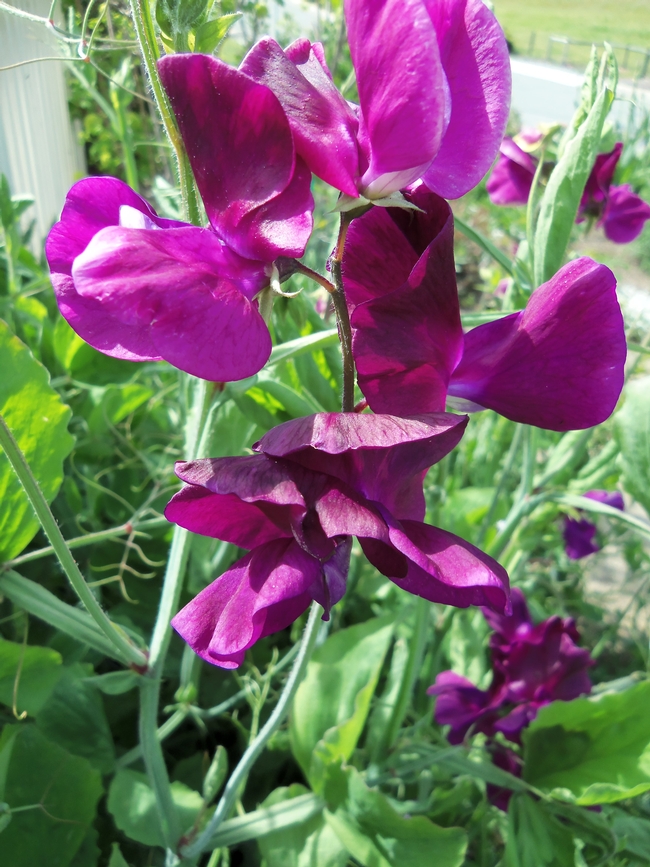
'Zinfandel' sweet pea. (photo by Karen Norton)
Perpetually Basil
If you were to checkout all the gardens in Solano County, you would most consistently find basil in either the border, vegetable, herb or flower gardens, in containers, raised beds, or baskets. A member of the mint family, Lamiaceae (Labiatae) is an annual noted for its rich, spicy, peppery flavor. Over 40 varieties exist ranging from light to dark green, purple and even variegated green and white with Sweet Basil (Ocimum basilicum) the most common. Flavors range from lemon, cinnamon, chocolate, and anise. In summer basil goes to flower (white or purple), but one, Ocimum pesto perpetuo, does not. This variety may over winter if you bring it inside or protect it from frost. In warm, tropical climates like its native India and Asia, basil has been cultivated as a perennial for more than 5,000 years.
Basil is easy to grow from seed, but make sure to keep the soil warm and the seedlings indoors until there is no frost danger. Once planted about 12 inches apart, you should prune the plants every 2-3 weeks to keep them healthy, bushy, and productive.
For use all year round, you can dry or freeze the leaves. Basil can be used in fragrant bouquets. (Ocimum is from a Greek verb that means “to be fragrant”.) It is a perpetual ingredient in Italian, Mediterranean, and Thai recipes. One of the easiest recipes is for Basil Bruschetta.
Ingredients
2 cups assorted cherry, grape, teardrop heirloom tomatoes, halved
½ small red onion, finely chopped
3 tablespoons olive oil
3 tablespoons chopped fresh basil
1 ½ tablespoons balsamic vinegar
1 garlic clove, minced
salt and pepper to taste
1 package crostini rounds or 1 loaf focaccia bread
Combine the tomatoes, onion, olive oil, basil, vinegar, garlic, salt and pepper. Let stand for up to 2 hours, covered at room temperature and tossing occasionally.
Serve on crostini rounds or focaccia cut in half, cut side up, brushed with a bit of olive oil and broiled to golden brown (about 2 minutes). Cut focaccia crosswise into 4 equal pieces.
Yummm and Enjoy.
Presprouting Sweet Peas
Good Saturday morning all. Just a bonus blog here. I wanted to include this photo in Sharon Rico's sweet pea article, but I didn't have it at the time the blog was posted. I wanted to share this with you if you were planning on planting sweet peas for your yard.
I too grow sweet peas and have taken Sharon's advice in pre-sprouting or 'chitting' sweet peas. I use the paper towel method. However, there are other methods of preparing sweet pea seeds for growing: soaking the seed in hot water, using sandpaper to scratch the surface of the seed or also nipping a tiny bit out of the seed coat.
In this picture are the dry sweet peas, the smaller darker colored seeds in the middle of the group. There are also the plumped up seeds. This happens just before they put out their first little root, which is the other seed you see here in this photo below.
My sweet pea seeds are planted and the seedlings are already breaking through the soil!
The Romance of Sweet Peas
October is the month to plant sweet pea seeds and I can hardly wait to get mine in the ground! In 1817, poet John Keats wrote “Here are sweet peas, on tip toe for a flight; With wings of gentle flush o’er delicate white, And taper fingers catching at all things, To bind them all about with tiny rings.”
Sweet peas, which have the descriptive Latin name Lathyrus odoratus, are incredibly gorgeous and powerfully perfumed. Often we smell them before we see the blossoms and the perfume invites us to find them, lifting our spirits and making us smile. Having a passion for sweet peas, I’ve been growing them annually for nearly 50 years.
It’s ideal to plant the seeds in an area where they can climb and be supported. Cement wire against a fence or wire between two poles in an open area will work well. The soil needs to be amended with compost and manure.
These tiny, round, hard seeds need to be soaked in water overnight. Soaking them softens the hard seed shell and encourages them to sprout. My grandmother placed her seeds on wet paper napkins on a tray in the basement and left them for several days until they were swollen and ready to “pop.” I use the same technique, using paper towels and an old cookie sheet. I carry that into the garden and place each seed individually 3 inches apart and ½ inch deep, thinning to 6 inches apart as they grow.
As soon as the plants emerge, grab some snail bait, as slugs and snails will feast on these seedlings! As the vines grow, they may need to be wound between the wire support until the tendrils grab hold. At this point, there’s not much to do until mid-April when the vines will vigorously grow and the incredible flowers appear. Sweet peas need to be picked daily for continuous blooming. The flowers will scent your home and are welcome gifts for friends and neighbors. As the vines turn brown and dry in June, there will be pods you can collect seeds for the following October. I’ve found that everyone loves sweet peas! Now, I’ve got to get busy!



